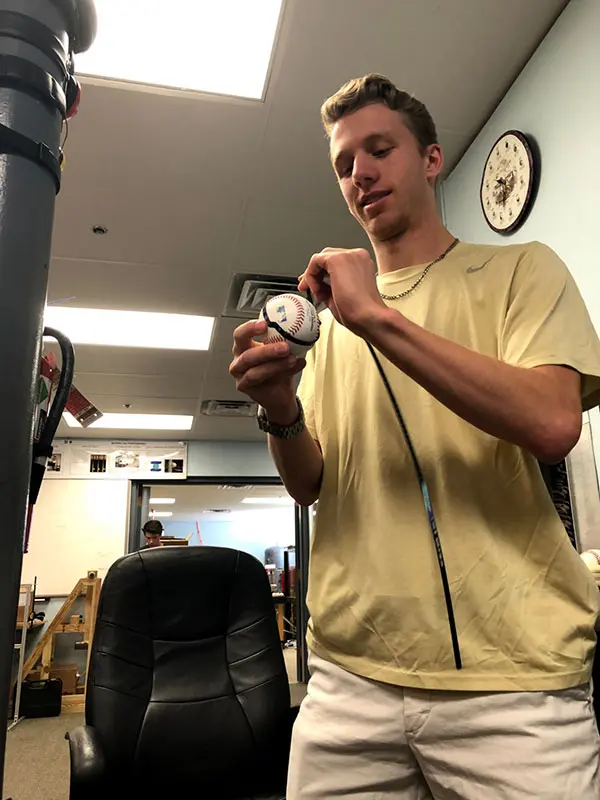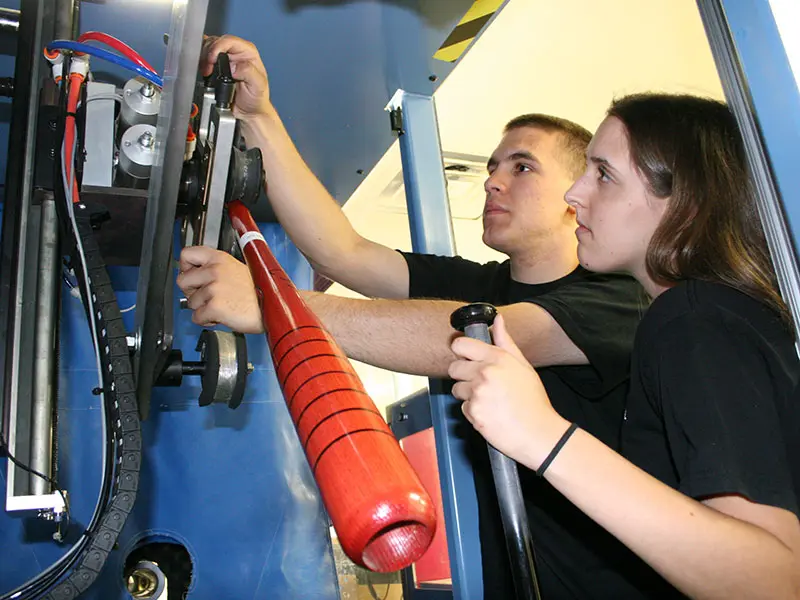From Testing Baseballs and Bats to Developing Advanced Polymers, Undergraduates Learn and Apply Skills in Campus Labs

Samuel E. Munnelly ’20
03/10/2020
By Edwin Aguirre
For Samuel E. Munnelly ’20, it’s a dream job come true.
Munnelly, a mechanical engineering senior from Litchfield, N.H., and avid Boston Red Sox fan, works as a student researcher at the university’s Baseball Research Center. Founded in 1999, the lab educates students in the field of sports engineering and conducts research on baseball equipment, some of which is sponsored by Major League Baseball (MLB).
“I love baseball. It’s the first sport that I played, starting at age five,” says Munnelly, who still gets out on the diamond as a member of UMass Lowell’s defending A League championship intramural softball team.
Undergraduates like Munnelly perform measurements on samples of baseballs, bats, helmets and sensors, and learn to use specialized air cannons to conduct high-speed impact testing of the equipment and materials.
“Students learn about the science and engineering of baseball using both experimental and analytical methods, while engaging with sports leagues and associations and sporting goods manufacturers in advancing the scientific understanding of sports equipment,” says Patrick Drane, the center’s assistant director.
“It’s a great experience being able to cut baseballs apart or launch them through air cannons and get paid to do it,” Munnelly says. “As far as I know, UMass Lowell is one of only two campuses in the country that has a baseball facility to do this kind of engineering research. The other one is Washington State University.”
Testing and Evaluating Baseball Gear
The Francis College of Engineering has a long history of educating and training students as researchers and innovators who can tackle real-world challenges and develop solutions for them. Across the engineering disciplines, students are offered learning opportunities that go beyond the traditional classroom setting.
Undergraduates gain graduate-level laboratory and technical skills by engaging in funded research under the supervision of faculty advisors or by doing paid internships and working at professional co-op jobs at local technology companies. They gather and analyze data, and their findings can get published in refereed journals. They also get invited to give talks or poster presentations at professional meetings across the country, all before they even finish their bachelor’s degrees.
In addition to sports engineering, students can participate in faculty-led research projects in areas such as nanotechnology, flexible electronics and renewable energy as well as functional fabrics, additive manufacturing, composites manufacturing, robotics, biomanufacturing and biotechnology, and others.
“At the Baseball Research Center, students are trained to use high-speed video to record ball and bat collisions (which last thousandths of a second), and then analyze the results,” Drane says.
In addition, some students work on their mechanical engineering senior capstone projects in the lab. The center is planning to offer sports engineering courses so undergraduate and graduate students can learn fundamental and advanced concepts such as strength of materials and aerodynamics that would prepare them to work at sporting goods manufacturers and other product development companies.
“As part of this effort, the baseball lab is working on a new campus initiative, Sports Collaborative for Open Research and Education, or SCORE, to increase sports-related offerings and collaborations across the university,” says Drane.
Mitigating A Concern
Munnelly has been a member of the center’s research team since his sophomore year, when he joined as an Immersive Scholar. His first task was to assist in grading the durability and characterizing the failures of different bats used in MLB games.

At UMass Lowell’s Baseball Research Center at Kitson Hall on North Campus, undergraduate students learn to use specialized air cannons to conduct high-speed impact testing of baseballs and bats.
Munnelly learned how to use the lab’s pneumatic cannon, which tested the durability of bats by launching baseballs at a fixed bat at speeds of up to more than 180 miles per hour. “We also used finite element analysis of the collision to simulate the effect of the baseball on the bat at various speeds and impact locations,” he says.
Munnelly is currently conducting compliance studies on Rawlings baseballs for MLB, to make sure those used in the regular season, all-star games, playoffs and the World Series are within the specifications set by league.
“Some of the tests we do include measuring the ball’s overall weight and circumference, its coefficient of restitution by launching the balls through a pitching machine, the tensile test of the leather and my personal favorite: layer-by-layer dissection of the ball,” he says. “The results are recorded, analyzed and compared to previous results and then compiled into a compliance report that we submit to MLB.”
Munnelly says he could use the skills he acquired at the Baseball Research Center in all engineering applications, not just in sports.
“Skills like finite element analysis, mechanical testing and report writing will help me become a successful engineer after I graduate,” he says. “The baseball lab has enabled me to gain relevant industry experience that I can’t obtain in a classroom. Accepting a position there is one of the best decisions I’ve made in college.”
Last summer, Munnelly completed his co-op as a manufacturing innovation engineer at New Balance in Lawrence, Mass., where he learned about all aspects of engineering that go into creating athletic shoes. “My plan is to continue working in the sporting goods industry as a mechanical engineer or a manufacturing engineer.”
Applying Synthetic Biology toPolymer Research
Elsewhere on campus, undergraduates are conducting cutting-edge research that could lead to new products or materials.
For example, Ethan S. Bossange, a senior chemical engineering major with a concentration in biological engineering, is working with Assoc. Profs. Carl Lawton and Nese Orbey at the Massachusetts Biomanufacturing Center (MBMC) at UMass Lowell to apply synthetic biology techniques to produce a thermoplastic material called para-polyphenylene, or PPP. Synthetic biology combines engineering principles with biology to design and fabricate biological components and systems that do not already exist in nature.
“PPP is the strongest and most temperature-resistant polymer, and is electrically conductive when treated,” says Lawton, who directs the MBMC. “The technology will lead to stronger, lighter materials for transportation, more efficient batteries and more durable biomedical devices.”
Students are playing a key role in synthesizing the polymer in the lab.
“Ethan and another undergraduate student, Olexandra Yeroshkina, have been instrumental in optimizing one of the steps of synthesis,” Orbey says.
PPP is a valuable bio-based chemical that is difficult to produce through any other traditional means, notes Bossange. “We had to take advantage of and genetically modify the cellular machinery that bacteria have been using for billions of years to produce PPP. As far as I know, this is the first time anyone has attempted this specific reaction and put efforts toward optimizing it,” he says.
Bossange believes the research has the potential to improve storage battery technology. “While renewable energy technologies have made considerable advancements in recent years, many experts cite batteries as a major bottleneck. Our final product could be used as a very strong and efficient electrochemical cell membrane for use in the next generation of batteries,” he says.
Bossange says being able to apply the concepts he learned from his biology, chemistry and engineering classes to his research and use state-of-the-art equipment and laboratory techniques will definitely help him in his professional career. “This summer, I will be doing my internship as a biopharmaceutical process engineer at Pfizer in Andover, before I return to UMass Lowell to finish my master’s degree in chemical engineering,” says Bossange, who lives in Framingham, Mass., and is a member of the Tau Beta Pi engineering honor society. “The education and training I’ve received at UMass Lowell have been top-notch.”
